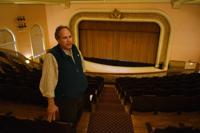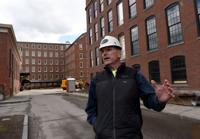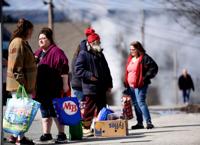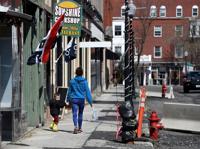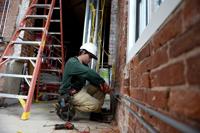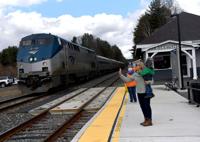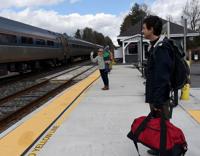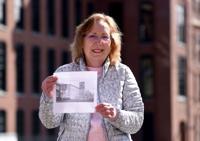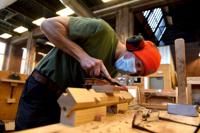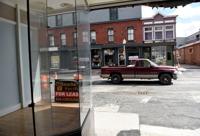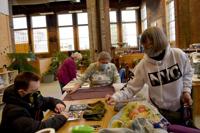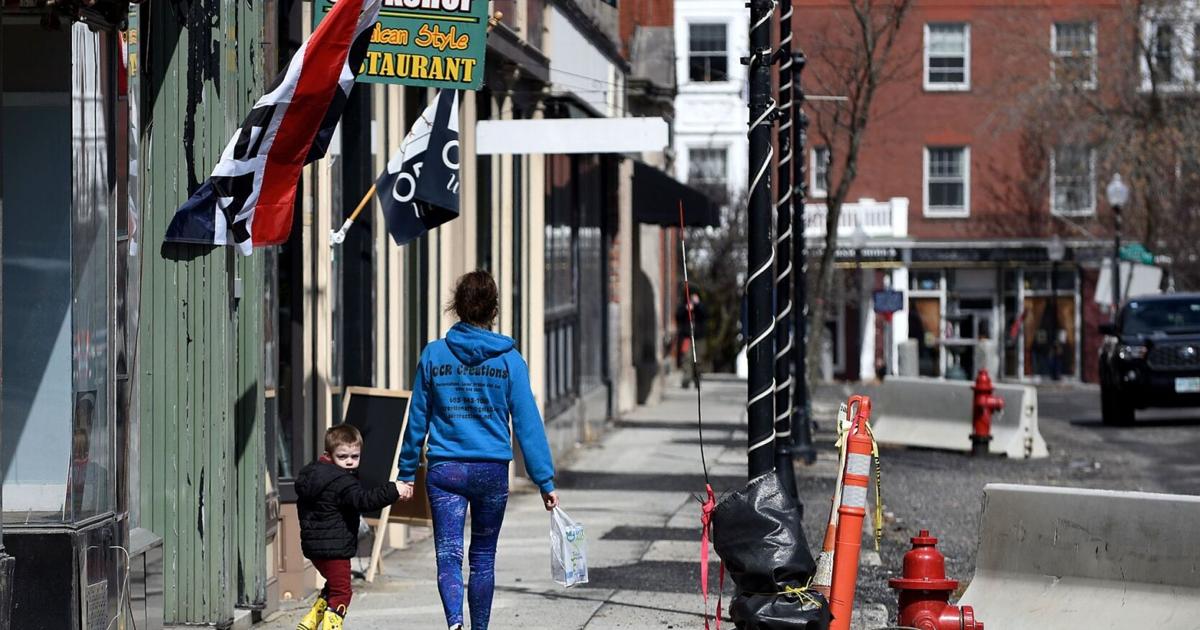
Claremont: Signs of success on a long road to revival | What’s Working
Table of Contents

What’s Working
CLAREMONT – Just off the main downtown square, beyond the book store and the travel agency, Keene’s Robin Kost spent two hours picking out $150 worth of spices, tea and coffee from around the world.
“It’s a destination business that will bring people from outside the city,” said Kost, who traveled 40 minutes to shop at Claremont Spice & Dry Goods.
She had another reason for her visit.
“We came to scout out places for business opportunities,” Kost said during a weekday trip this month.
Claremont, a former mill city 50 miles west of Concord, is a community looking to turn the corner, showing sprouts of new development and attracting fresh businesses.
Kost will have plenty of choices for relocating, with at least six vacant storefronts alone on Pleasant Street, a spoke off Opera House Square that is getting its own facelift.
“We’re kind of on the cusp of the next discovery phase,” Andrew Pinard said during a tour of the Claremont Opera House he oversees as executive director.
Many communities, including Claremont, “are reimagining who they are,” he said.

AndrewwPinard speaks with a reporter while giving a tour of the Claremont Opera House.

Chiara Tosi-Nelson and her husband, Ben, give a tour of their shop, Claremont Spice & Dry Goods, in Claremont.
Claremont on the map
More people know Claremont for its lawsuit to change public education funding than can find it on the map.
Recently, pandemic resettlers and commuters searching for cheaper housing have taken to Google in hopes of finding cheaper real estate in Claremont.
Prices for owner-occupied homes in the city are half as much as those in Lebanon, its high-tech neighbor to the north, according to U.S. Census figures. In 2020, Lebanon overtook Claremont in population.
Rising rents and home prices in the Lebanon-Hanover area have forced some workers to live farther from their jobs — or to turn down job offers when they can’t make the numbers work.
“We are definitely seeing people … accept a job and then start to explore the housing market here and then withdraw acceptance,” said Carolyn Isabelle, director of workforce development at Dartmouth-Hitchcock in Lebanon.
The health care system is talking to developers of 83 apartments in a former mill building just off the downtown square about renting a block of units for workers.
“As a component of our recruitment strategy, we’ve had to secure apartments,” said Dave Duncan, vice president of facilities management at Dartmouth-Hitchcock.
“What we found is we’ve widened our search for apartment buildings within that 45- to 60-minute radius around Hanover, and that’s how we came across Claremont,” Duncan said.
Over the past 14 months, Dartmouth-Hitchcock has reserved about 100 apartments for workers, mainly in the Upper Valley.
“If we’re successful in Claremont, that will be our farthest one,” Duncan said.
“We identified that as a really good prospect, especially for recent graduates,” Duncan said. “We also realized, boy, when that gets filled, that will spur a lot more growth in that area” that young professionals will crave.
Red River, a technology firm on the same street as the new mill housing, said its executives also have had discussions about renting units there for workers.

John Brighton of Chinburg Properties gives a tour of a mill renovation project along the Sugar River in Claremont.
John Brighton, site superintendent with Chinburg Properties, said the apartment complex, named Monadnock Mills, should open this summer and “will attract small businesses, small eclectic-type things people want to walk to.”
Claremont is “one of the few places in New Hampshire, except perhaps Berlin, where you still can buy a house for $150,000 to $200,000,” Brighton said from atop the roof of the five-story building. A rooftop deck will provide a view of downtown Claremont and Vermont’s Mount Ascutney.
Studios at Monadnock Mills will start at $995 a month, with two-bedroom units topping off at $2,135.
The Chinburg project’s opening has been delayed a couple months because the developer couldn’t find enough people to work on-site, according to project manager Rob Pearson.
Full occupancy could happen within six months of taking deposits. “It could even be three months,” he said.
Workers in the Upper Valley need to do their own commuter calculations about driving 30 to 45 minutes to Claremont.
“That is part of our questions: How far do you commute to work and do you want to commute?” said Tim Josephson, associate planner at the Upper Valley Lake Sunapee Regional Planning Commission.

John Brighton of Chinburg Properties gives a tour of a mill renovation in progress for 83 apartments along the Sugar River in Claremont.
New viewpoint
Nurses and computer programmers could soon be moving into homes in a mill that once bustled with textile workers.
Settled in the 1760s, Claremont harnessed the Sugar River to power the mills that produced paper and textiles but were silenced decades ago. Many of those brick buildings, however, remain today, offering opportunities to capitalize on the river view.
Since 1980, Claremont has lost 11% of its population. In the same timeframe, the state has gained 47% more residents.
“A lot of young people in my generation have moved away, and a lot of the older population is aging out and dying,” said Benjamin Nelson, a 2013 graduate of Stevens High School and co-owner of the spice shop.
More Latino, Black and Asian people are moving to the area.
“It’s nice to see people … who didn’t grow up right here, who have a fresh set of eyes who see the opportunity Claremont has,” said Nelson, who bought the spice store in 2019.
“Immigrants are very inclined, like my wife, to be business owners,” said Nelson. His wife is from Italy.
And new businesses will attract more visitors.
Many young professionals want a lively place to live, according to Dartmouth-Hitchcock’s Isabelle.
“The more vibrancy we can bring into these communities, the better the chance we have in retaining them and seeing them really put down their roots and grow their careers here,” Isabelle said.
Walkable city
Last summer, Josephson, the regional planner, walked many of Claremont’s sidewalks for his work.
“You can easily walk to a lot of places,” Josephson said. “They have a real planned-out city. It’s very compact, which is kind of a testament to its history. By having that, you have all your infrastructure in place.”
Josephson has lived in the Upper Valley for 20 years.
“I definitely think it’s a community on the upswing,” he said. “It’s got lots of potential.”
“From my perspective, I think the people of Claremont see what similar cities in the state can do — Franklin and Somersworth, to name a few,” Josephson said.
Both of those former mill cities are seeing increased reinvestment and redevelopment.
Claremont’s commercial strip along Washington Street includes a Market Basket, a Hannaford supermarket and a Walmart Supercenter. Hobby Lobby and a state liquor store occupy the spot where Sears once operated. The city also has its own hospital.
City challenges
Some residents say the city isn’t making enough strides.
A woman named Cindy picking up free groceries and a free meal at the Claremont soup kitchen talked about discarded trash and drug dealing.
“If I had kids, I wouldn’t bring them downtown to see all that,” said the 25-year Claremont resident.
“What Claremont needs is a factory to come in and hire … the illiterate people that can’t read or write,” said Cindy, who called herself semi-retired.
When asked how long she had lived in Claremont, Coriander Deveney, 37, responded: “Unfortunately, almost my whole life.”

People line up for food in front of Claremont Soup Kitchen. Median household income in the city is about 60% of the state average.
Deveney, who cleans houses and works in home care, said the city has seen some improvements.
“But still not a lot of options for kids to do, things to keep them out of trouble,” said the mother of two sons, a teenager and an adult.
Stephen Janelle, 69, who lives in Unity, said he tries to hit the soup kitchen for three meals a day. He thinks Claremont has slipped.
“It’s gotten worse,” the white-bearded man said. “They don’t have that many businesses in this area,” he said.
Budding businesses
This month, Samantha Charles opened up Petal Patch 2 Flowers & Specialty Gifts on Pleasant Street. She stocks local products, such as candles, as a way of helping local businesses in this city of 13,000.

A redevelopment project is underway on Pleasant Street in downtown Claremont. The city has added angled parking on the street with plans to upgrade sidewalks and add new lighting, landscaping and benches.
Despite empty commercial space downtown, one storefront owner wanted $4,000 a month for rent.
“It was hard to find something affordable,” Charles said. “This is not a rich town, by any means.”
According to Census figures:
1 in 6 Claremont residents lived in poverty in 2020, compared with 1 in 14 statewide.
Claremont’s median household income of $46,848 in 2020 was more than $30,000 less than the statewide average.
The state’s median value for owner-occupied housing units was more than double Claremont’s $133,400.
Claremont’s unemployment rate of 2.1% in February, however, bested the statewide number of 2.5%.
Real estate agent Bonnie Miles said a majority of people moving into Claremont recently were from southern New England states, often motivated by the ability to work from home.
“The part that really hurts is I’ve been working with (local) buyers who are excellent FHA buyers or New Hampshire Housing,” Miles said. “They need government assistance loans, and these buyers from out of town come in and pay big money and the hard-working couples, they’ve got kids and they’re making it, but they can’t buy a house because people are coming in and beating them to it.”
The city’s 2017 master plan hoisted a warning flag for the city’s housing picture.
“The aging housing stock, coupled with limited new housing construction, limits the housing choice for new residents,” it read. “Poor quality housing stock has been cited as the principal housing issue in Claremont.”

Ryan Hays of Deering works on wiring a condo at a mill under renovation in Claremont.
Kevin Lacasse’s company, New England Family Housing, leases out about 100 apartments in Claremont, including the renovated Goddard Block Apartments on Pleasant Street. He doesn’t expect much new housing construction in Claremont.
“To build a single-family house right now, you’ve got to be selling them in the $400,000 to $500,000 range to make a single-family subdivision worthwhile,” he said. “I don’t see those prices achievable in Claremont at this juncture.”
That means the housing shortage “will continue to put increased pressure on rents and sales in Claremont,” Lacasse said.
Transportation links
Commuting by bus between Claremont and Lebanon became an option last summer.
An 18-passenger bus attracted 712 riders through December. Another 603 rides were taken between January and late March. The bus stops include Dartmouth-Hitchcock Medical Center and Lebanon City Hall.
“Making people more mobile, it opens up a lot of opportunities,” said Beth Daniels, CEO of Southwest Community Services, which operates the bus. “If we were in New York City, everyone would take public transportation. Here, we need to sell the idea.”
Dartmouth-Hitchcock already runs shuttle buses between its medical center and some apartment complexes in the Lebanon area for all three shifts, Duncan said.
The key to the Claremont bus line’s effectiveness is aligning bus arrivals with employee schedules, officials said.
Claremont also boasts the only Amtrak stop in western New Hampshire (though another stop is just across the border in White River Junction, Vt.)

A southbound Amtrak Vermonter train pulls into the station in Claremont.
Amtrak’s Vermonter makes two stops a day in Claremont on its route between St. Albans, Vt., and Washington.
Claremont residents Claire and Walter Stapleton greet train riders, wearing caps identifying themselves as “train hosts.” The Stapletons give directions and share tourist tips with arriving passengers. Occasionally, they give someone a ride downtown.
“Especially in the winter time, we stay with them until they have a ride,” said Claire Stapleton.
The volunteers put out a yellow metal step stool for passengers to get on or disembark.
On a recent weekday, one person got on the southbound train — a Yale student, Finn Gibson, after visiting a relative in nearby Unity — and one got off.

Yale student Finn Gibson gets ready to board an Amtrak train in Claremont after visiting a relative in Unity. Amtrak’s Vermonter stops in Claremont on its daily runs between St. Albans, Vt., and Washington.
That day’s engine and five cars ran seven minutes late for its 12:06 p.m. scheduled arrival. Loading and unloading took about a minute.
“It was a real quick one,” said Walter Stapleton, a state representative.
A half-dozen people might get off the northbound train, which arrives in the late afternoon.
The opera house’s Pinard would like to take advantage of the Amtrak station, maybe organize a regional music festival, but there are challenges.
“We don’t have a lot of lodging,” Pinard said.
Occupational shifts
Around the turn of the 20th century, Monadnock Mills employed more than 600 workers. When it closed in 1932, only 125 remained.
“Like a lot of other communities, Claremont is not unique in the sense that it had a fairly robust urban industrial center and over time as the mills started to close, it’s a big transition for a community,” said Nancy Merrill, director of the planning and development department.

Nancy Merrill, director of Claremont’s planning and development department, holds an old photo showing one of the Monadnock Mills buildings being redeveloped for housing.
“It’s been 15 to 20 years that the city’s really been working on it,” Merrill said of Claremont’s transformation. “It’s not something that happens in a day or even in a year. These kinds of transformations, they take a long time.”
Claremont solicited proposals to sell off several mill buildings. In 2008, it built a pedestrian bridge, funded mainly with state money, that spans the Sugar River, connecting the downtown and mill area with a city park and visitor center.
Around the same time, Red River moved its headquarters into one of the Monadnock Mills buildings. It has since expanded the space it occupies.
An advantage is “not having to have multiple buildings miles apart,” said Richard Ackerman, Red River’s vice president of workforce development. “Just the capability there. We could park people at the parking garage Claremont built” that’s attached to the building.

A pedestrian bridge over the Sugar River connects a park with the mill buildings downtown.
The Common Man franchise has opened a restaurant, complete with an outdoor patio, and a 30-room inn inside the mill complex adjacent to the Sugar River.
The city still owns a couple of properties on the non-mill side of the Sugar River that officials are mulling how to use. A brewery was one idea floated.
Claremont hired the same New York engineering firm that worked on Concord’s Main Street project to redesign Pleasant Street, Merrill said.
Once completed, the street will feature wider sidewalks as well as new lighting, landscaping and benches, she said. Traffic already has been converted to one way with angle parking.
“I think over time those towns have to reinvent themselves, and I think they’re slowly in the process of doing that” in Claremont, Lacasse said.
The city remains home to a handful of active dairy farms.
“There’s not a lot of sprawl,” Merrill said.

Eric Diven of Long Walk Woodworking works on a project at the Claremont MakerSpace.
UNION LEADER
Eric Diven builds high-end furniture, but he doesn’t have his own workshop or high-priced tools.
He pays $312 a month for 10-by-10-foot workspace and use of shop tools at Claremont MakerSpace, a creative hub run by a nonprofit organization.
“I can do a lot of work here in my booth,” said Diven, a white church steeple visible through the window. “Setting up a shop is pretty expensive to do.”
The maker space opened in 2018 in the former Sawtooth mill building and now has 111 members, mostly hobbyists drawn from a 40-minute radius, according to Executive Director Steve Fortier.
“We have several professionally run businesses out of MakerSpace,” Fortier said.

A leasing sign is in the window of an empty storefront on Pleasant Street in downtown Claremont. The city has added angled parking on the street with plans to upgrade sidewalks and add new lighting, landscaping and benches.
“Downtown Claremont has a lot of vacant storefronts,” Fortier said. He is working with the city to get some of the MakerSpace’s products into those store windows in an effort to promote the effort.
Diven and his wife, who works at Dartmouth College, have been looking for a house for 10 months.
“We still haven’t found the right spot for us” in their price range, Diven said.
Member Allison Zito of Claremont makes quilts and has organized a community talk on climate change.
The MakerSpace creates an environment “to be surrounded by like-minded people invested in the future and searching for the greatest in themselves,” Zito said.

Debi Barton-Haverly, at right, works on a quilt project while sitting with her son, Jamie, at Claremont MakerSpace.
Just before the pandemic started in 2020, the Nelsons bought a home in Claremont that Ben Nelson now estimates has gained 25% to 40% in value.
It’s a 10-minute walk from their spice shop.
“One time,” said Nelson’s wife, Chiara Tosi-Nelson, “we snowshoed in the middle of a snowstorm.”


